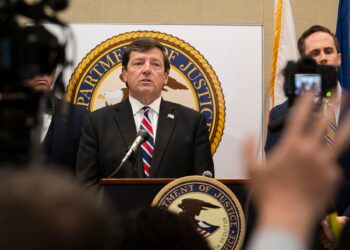After a 17-year-old was charged with the fatal shooting of 14-year-old Eugene Kelly in Jackson, Mississippi’s first murder of 2024, one council member made a familiar demand: Impose a nighttime youth curfew to “stop these kids from becoming killers.”
Mayor Chokwe Antar Lumumba then offered an even stronger response: The city should create “youth engagement centers” to keep children off the streets after dark.
Curfews have been imposed and abandoned numerous times in Jackson over the decades. Lumumba invoked the last temporary curfew in 2021, following a surge in violence during the COVID-19 pandemic. The planned youth centers, he said, will get “to the root cause of why that young person may be on the street,” instead of “detaining them and becoming part of the problem.”
Other U.S. cities have enacted curfews and set up youth centers, with mixed results. National studies have shown that curfews usually don’t stop violent crime. The Marshall Project – Jackson examined the practices of youth centers in Baltimore and Philadelphia. A summary of the findings is below.
In Jackson, city officials believe the engagement centers would become a safe space to keep kids away from potentially dangerous situations. The children would have to agree to be taken to the centers or go home; police cannot force kids on the street to attend after the curfew.
The city’s curfew ordinance, which passed the city council unanimously in January, said youth cannot be out past 10 p.m. on weekdays and midnight on weekends. The ordinance expires in January 2025. However, Hinds County Youth Court Judge Carlyn Hicks deemed it unenforceable, as youth cannot be arrested for violating the curfew because adults cannot be charged under the same law. Youth between the ages of 10 and 19 make up 14%, or around 20,000, of the city’s 146,000 residents, according to the U.S. census.
Fighting youth crime is a political cry often used by elected officials, law enforcement and city leaders across the nation. Councilman Kenneth Stokes, who pleaded to stop kids from becoming killers at a January council meeting, has been demanding curfews since as early as 1991.
Jackson’s budding plan for centers, however, faces a challenge in winning the trust of young people, who are already skeptical of police and feel that they are villainized in conversations that don’t include them, youth advocates say.
Gus Daniels-Washington said young people often face outsized blame for crime while not enough is done to fix what pushes youth to violence. Daniels-Washington is the founder of JXNOLOGY, a nonprofit, youth-led arts and advocacy community in the city.
“It really just takes the responsibility off of our community leaders, because who is teaching these young people?” Daniels-Washington said of a curfew. “It’s not like there’s a class in murder.”
In their first public meeting of the summer on June 27, the city police’s precinct captains presented crime statistics that showed more theft and more 911 calls than from the previous week. Police Chief Joseph Wade attributed the rise in crime to youths.
“We know what the issues are,” Wade said. Kids are out of school, “and some of them are finding something productive to do, like stealing your stuff.”
Violent crime committed by and against young people has been a long-term concern in the city. Less than a month into the summer, 18-year-old Daivion Myles was killed in a drive-by shooting. Four teenagers, including a 13-year-old girl, were charged with his murder.
However, according to police records obtained by The Marshall Project – Jackson from the first half of the year, the majority of people arrested for violent crimes were adults. Though the city shares poignant examples of youth violence, it provides no evidence to the public that youth violence is actually on the rise. The police department does not report data to the FBI system that tracks crime data nationwide. Nationally, youth only accounted for 7% of arrests for violent crimes in 2020, according to the Bureau of Justice Statistics.
According to Judge Hicks, about 20% of the youth court docket in 2023 involved “juvenile delinquency,” or youth crimes. The remaining almost 80% of cases involved child welfare, including abuse or neglect. At a juvenile justice forum held on April 27, Hicks said that while news stories portray rampant crime among young people that captures the public’s attention, “the true underbelly of concern in Hinds County,” is that many of the children are vulnerable to abuse and neglect.
Darius Nelson, a 26-year-old organizer with the youth group JXNOLOGY, and several other young adults interviewed said they felt isolated, unheard and overpoliced. Nelson uses they/them pronouns. Young people in Jackson are tired of being “the big, bad, boogeyman,” they said. “That’s followed me all my life.”

Keisha Coleman, director of the city’s Office of Violence Prevention and Trauma Recovery, said she is designing the youth engagement centers with multiple factors in mind. Children living in the city are dealing with trauma, poverty and a criminal justice system that has been historically unfair, she said. Many are growing up in neighborhoods that haven’t seen new investments of resources in decades. Although the centers were supposed to be open from Memorial Day to Labor Day, the plans were pulled from the city council’s agenda ahead of its July 2 meeting. No budget has been presented, and the city has given no reason for the delay.
JXNOLOGY gathered teenagers and young adults ahead of a May council meeting to speak on their concerns about what they called “curfew centers” and hoisted signs for the council members and the public to see. One read, “Y’all couldn’t come up with something that actually works?” Another asked if they would curfew adults.
The Marshall Project – Jackson looked at what worked and what didn’t for similar youth programs in other U.S. cities. Leaders in Baltimore and Philadelphia offered the following suggestions as Jackson plans for its youth centers:
1. Curfews and curfew centers are not standalone solutions for youth violence.
Across the country, curfew ordinances have come and gone with crime waves throughout history. It’s an often repeated cycle. When a handful of violent crimes or a single high-profile crime catches the city’s attention, leaders often impose curfews.
However, academic research shows that curfews do not impact crime rates. Coleman said that violence among youth between the ages of 12 and 24 in Jackson happens mostly between 3 p.m. and 8 p.m., before nighttime curfews usually start, which aligns with national findings from the Office of Juvenile Justice and Delinquency Prevention.
Still, generations of Jacksonians have lived under curfew ordinances. Jackson Police Captain Christian Vance remembers growing up with a curfew in Jackson. While he said the curfew did not affect him, “as a kid who lived within boundaries,” he believes that limiting the hours a youth can be outside is useful. It’s not a magic elixir, he said, but a curfew does give police the opportunity to find kids who need help. Vance runs the department’s youth programs, including the summer Youth Citizens Academy and Police Athletic League.


While curfew centers add another layer to the strategy, they are also not enough.
In Baltimore, for example, no young people went to that city’s engagement centers during the first three weeks of this summer’s curfew. Last year, the city had “less than a handful” of young people come in, according to Shantay Jackson, former director of the Mayor’s Office of Neighborhood Safety and Engagement, who developed the centers.
Low attendance is common across cities with similar programs. Instead of going to the centers, teens may opt to go home or, in Baltimore, attend other city-sponsored events. Jackson said she views the summer strategy as a success despite low attendance at the centers. Baltimore’s officials touted an 83% decrease in youth homicides from Memorial Day to Labor Day in 2023, though there is no firm evidence that the curfew efforts caused the drop. Murders decreased significantly across the nation in 2023, according to FBI data.
Similarly, of the more than 1,000 youth who attended a Philadelphia community evening resource center from the start of the curfew in July 2022 to November 2023, about nine out of 10 children were walk-ins who participated in the centers’ programs, which included driver’s ed classes, boxing, music production and culinary classes.
The key to success, leaders in both cities said, was assessing each child’s needs and offering them something interesting to do. Children are not inherently violent. Angelic Bradley, who runs one of Philadelphia’s six centers, said kids often violate curfew out of boredom. In other cases, they may be trying to escape abuse or other unsafe situations at home.
2. Police shouldn’t be heavily involved.
Although Jackson police officer Vance and others said they want to help children stay safe, young people interviewed said they fear more police encounters could open doors for harassment, violence and over-policing. Some say they have had violent encounters with police. Others have watched widely shared videos of police killing young people like 15-year-old Ryan Gainer in California and shooting 11-year-old Aderrien Murray in Indianola, Mississippi.
If police lead the engagement center efforts, “it’ll be questioning, it’ll be harassment, and just making young people feel like they don’t have a space where they can go and feel safe,” said 25-year-old Eboneé Beard of Jackson. Beard is part of the Youth Action Initiative, a group that hosted a forum for young people to share their issues and brainstorm solutions.
In Baltimore, Shantay Jackson said it’s important to consider how Black communities have been over-policed for decades and not criminalize young people for just wanting to have fun.
Instead of police cars with flashing lights, the city used a bus with youth ambassadors and social workers to disperse kids hanging out after curfew. In Baltimore and Philadelphia, the centers were staffed with social workers, mentors and trained young adult ambassadors. Bradley’s center has one armed security guard, but no police officers present.
3. Kids need a stake in creating their own safe spaces.
When creating a space with young people in mind, it is important to involve youths in the planning, leaders in all three cities and young adults said.
“If we trust the young people to make informed decisions about their future, I think that we would see that young people are able to articulate their issues, and they’re also able to articulate solutions,” said Nelson of Jackson’s JXNOLOGY. They believe kids should be given not only a say-so, but the resources to create their own solutions.
Jackson, of Baltimore, said her team met with hundreds of youth to learn what they wanted. The results, in addition to the connection centers, were social events like pool parties, concerts and rollerskating.
4. Food and simple offerings go a long way.
In Baltimore and Philadelphia, the centers provided hot meals. At one center in Baltimore, which saw only two kids last summer, both asked for food. In Philadelphia, Bradley offers information about housing programs and grant applications that she helps families fill out. Her center also provides transportation for kids wanting to participate in their programs.
In Jackson, both Coleman and Daniels-Washington agreed that young people have basic safety needs that must be addressed.
Coleman said the city cannot continue to try and “arrest away” youth violence.
Daniels-Washington said if the city does not listen to its youth, “Jackson will become a dying city.”



























